
Aug 2, 2019
Caption: On the International Stroke Day 2018 our members HEILAHEILL, patients, neurologists, etc. to promote the disease and disseminate information to the public in KRINGLUNNI, Reykjavik’s largest shopping center, which attracted much attention. Chairman of HEILAHEILL Thorir Steingrimsson and the specialist in neurology (thrombectomy) Bjorn Logi Thorarinsson in National University Hospital of Iceland | LSH · Department of Neurology.
“According to circumstances in ICELAND we are unable to make significant survey on prevention, treatment and rehabilitation of the stroke or exploring the burden of the stroke because we have only 360.000 citizens. Therefor it is difficult for the authorities to answer our queries about the incidence of stroke across the country. But however we are trying to follow Stroke Action Plan for Europe 2018-2030 by taking the guidance of professionals and health authorities” says the Chairman of HEILAHEILL, Icelandic stroke support organisation, Thorir Steingrimsson.
SAFE: What is one issue related to the life after stroke in your country that you think needs special attention?
TS: Being in SAFE gives us the opportunity to compare ourselves with other health systems in other European countries regarding the stroke. Many things are similar to us and the other Nordic countries, but there are a number of factors that are similar to the burden of the stroke with other nations, for example there is a lack of follow-up from the healthcare system, when individuals are enrolled in the community. The main problem in our country is that the health authorities and ÖBÍ (The Organisation of Disabled in Iceland) which we accept money from, do not recognize aphasia after stroke as a special disability category in the healthcare system, but it is mixed with aphasia due to age or other trauma. The majority of those who have aphasia after stroke in our country do not experience themselves as ratifying the citizens of society. It is a great shame. Therefore, HEILAHEILL has worked with professional, speech therapists and other patient associations to raise the awareness of the health authorities and the public of this disability. We realize that this is starting to work, as the current government is beginning to recognize the problem i.a. support us financially specifically in equating education with this disability category
SAFE: What would be the solution, i.e. what is your organisation’s position regarding this issue?
TS: We still have opportunity to do many things, which larger nations find difficult to do, for example make a plan for decision party about stroke treatments over the hole country. In comparison, we can be likened to a little drill next to a big oil ship.
Healthcare professionals have done tremendous progress in thrombectomy, over the past two years in Landspítali in Reykjavík, which is the largest and leading factor in healthcare in the country and estimate it to be national 2020! HEILAHEILL has decided to introduce this improvement among the public and in the country and use this opportunity to raise public awareness of the first signs of stroke and and urges the public to push the government to put more money into reducing the burden of a stroke!
SAFE: Please tell us more about your organisation.
TS: HEILAHEILL is a independent companionship for stroke survivors with individual membership for the whole country. The company have opportunity to meet the decision-makers by the authorities face-to-face, and they have supported us in our policy and it is also close relationship between people In HEILAHEILL and professionals over the country.
Therefore there is compelling evidence in ICELAND that stroke is highly preventable, treatable and manageable, and there is a potential to drastically decrease the burden of stroke, including substantially reducing its long-term consequences. This requires the joint actions of Ministries of Health and Social Care, other governmental bodies, scientific and stroke support organisations, healthcare professionals, clinical and preclinical researchers and industry and most of all, a good and powerful communication with patient organizations.
The benefits of tPA in patients with acute ischemic stroke are time-dependent, and guidelines recommend a door-to-needle time of 60 minutes or less. Professionals in Iceland say the average has dropped from 80 minutes to 25 minutes in the last three years!
HEILAHEILL has released an app in smartphones with information on the first signs of stroke. And when it is inserted in the beginning you place your social security number, it makes it your personal safety button to the emergency line and they positioning the device with precision. The smartphone tells who is calling for help, age, gender, wherever you are in the country!
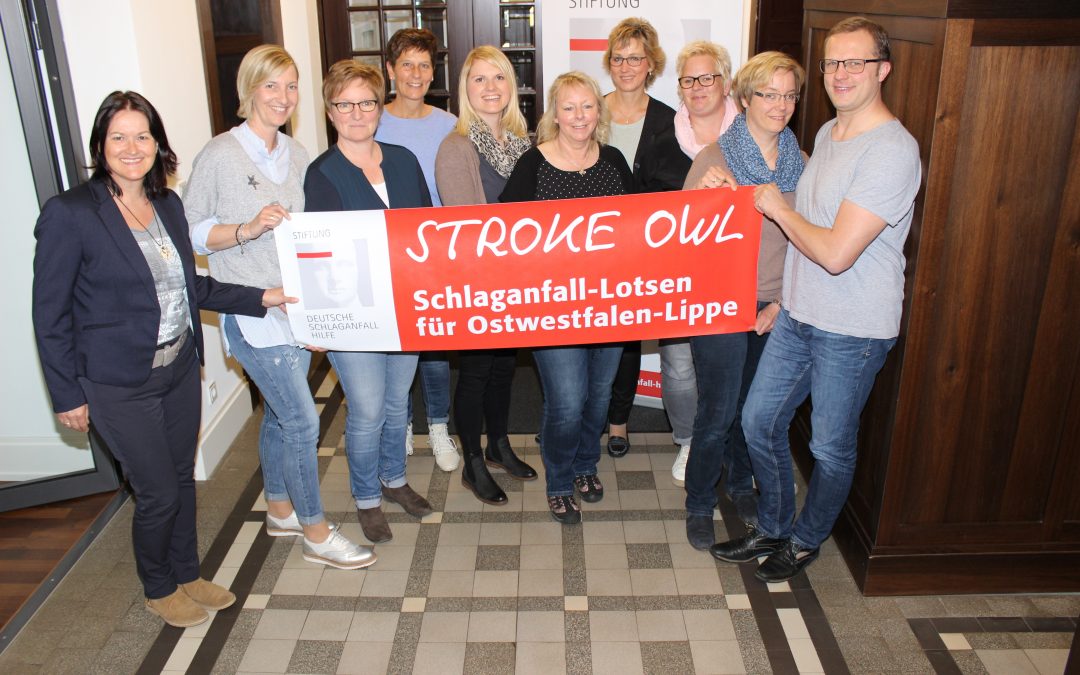
Jul 30, 2019
The celebrations of the 25th anniversary of the German Stroke Foundation officially ended on its birthday on January 29th 2019. Of course the work on many projects and events continues. Here are some examples.
New Case Manager for children with stroke
 The second “Case manager for children with stroke” (Schlaganfall-Kinderlotsin) was installed at the beginning of the year. Franziska Schroll works at the Schön Clinic in Vogtareuth (Bavaria) and will support families with stroke-affected children in southern Germany. The foundation “RTL – We help children” finances the project for two years.
The second “Case manager for children with stroke” (Schlaganfall-Kinderlotsin) was installed at the beginning of the year. Franziska Schroll works at the Schön Clinic in Vogtareuth (Bavaria) and will support families with stroke-affected children in southern Germany. The foundation “RTL – We help children” finances the project for two years.
The case manager provides information about stroke and helps families to get all the treatments, therapies and social support they need. The other case manager, Marco Vollers, continues his work in Bremen and is responsible for the northern part of Germany.
Seminar for parents
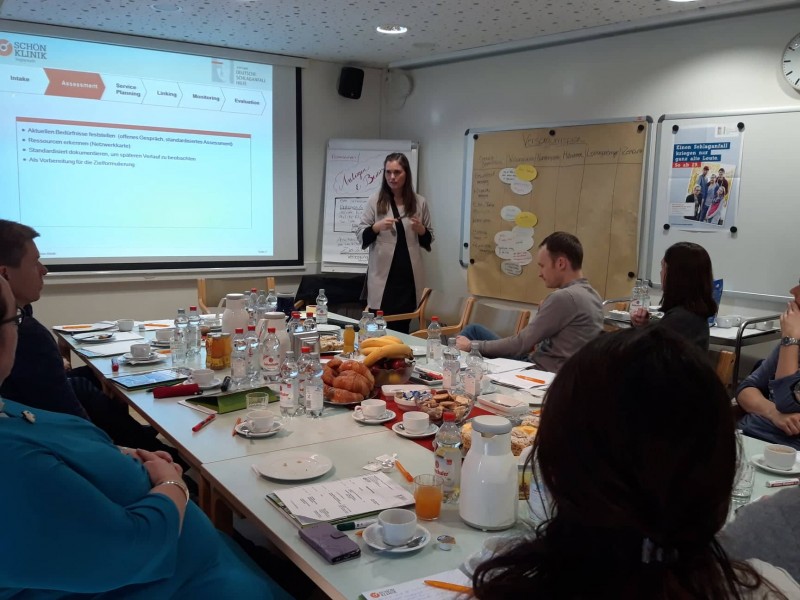
When a child has a stroke, the parents have many questions. Which therapy is best? Which lasting consequences will the stroke have? Will my child need special support at kindergarden or at school? How will the family cope with the difficult situation? Experts answered these questions at a seminar for parents. Parents had the chance to get general information about stroke and discuss their individual situation with doctors and therapists.
Stroke-scan “in jail”
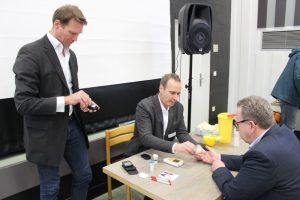
Many people have high blood pressure or diabetes and don’t know about it. This is why the German Stroke Foundation offers to scan the risk of stroke at work. At the beginning of the year the testing took place in a very special location: in jail.
Jail-employees had the chance to test their risk of stroke and discuss stroke prevention. Alexander Leipold, former professional wrestler and ambassador of the foundation, talked about his rehabilitation and motivation after the strokes.
Workshop for leaders of self support groups
The foundation offers workshops for leaders and spokespersons of self support groups. In 2019 they took place in Hamburg, Halle and Zwickau. The participants learn for example about new laws, how to finance their group, how to use social media and discuss many questions. The workshops help them to be up to date and pass important information on to the other group members.
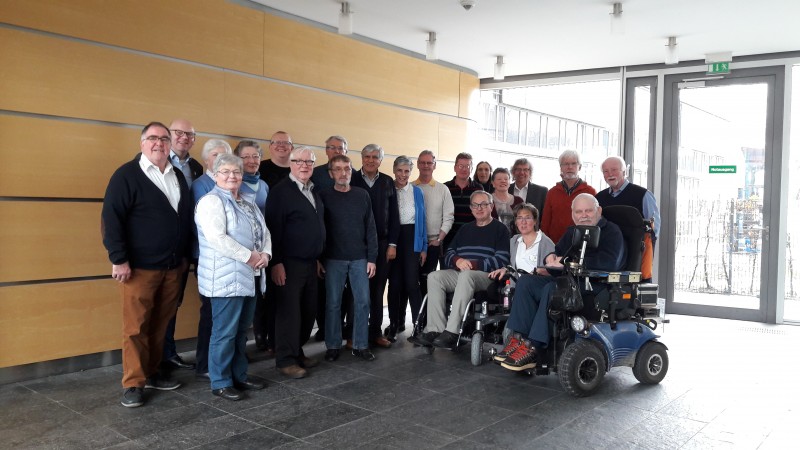
Case Management Symposium
The project “STROKE OWL” is continuing successfully. Professional case managers support stroke survivors in the region Ostwestfalen-Lippe (OWL = East part of Westphalia covering 2 million inhabitants) for one year.
With this project the foundation wants to proof that a close support after the stroke can improve the quality of life of stroke patients and reduce the risk of further strokes. 1,5 years into the project the foundation organised a symposium for case management experts to discuss the outcomes and challenges to date.
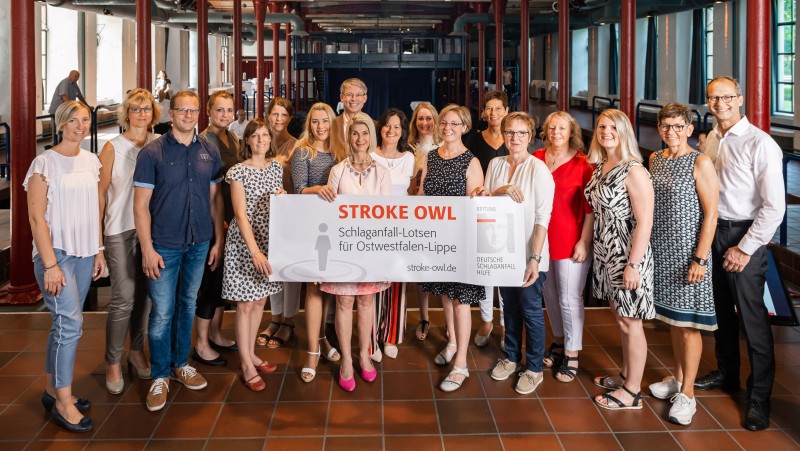
Stroke in daily soap
“Unter uns”, a popular German daily soap on RTL-television, picked up stroke as a topic in the storyline. One of the main characters gets a stroke and suffers from paralysation and aphasia afterwards. The foundation supported and advised the crew. Actors visited the foundation and spoke to stroke patients to prepare for their roles and employees of the foundation gave advice on the script.
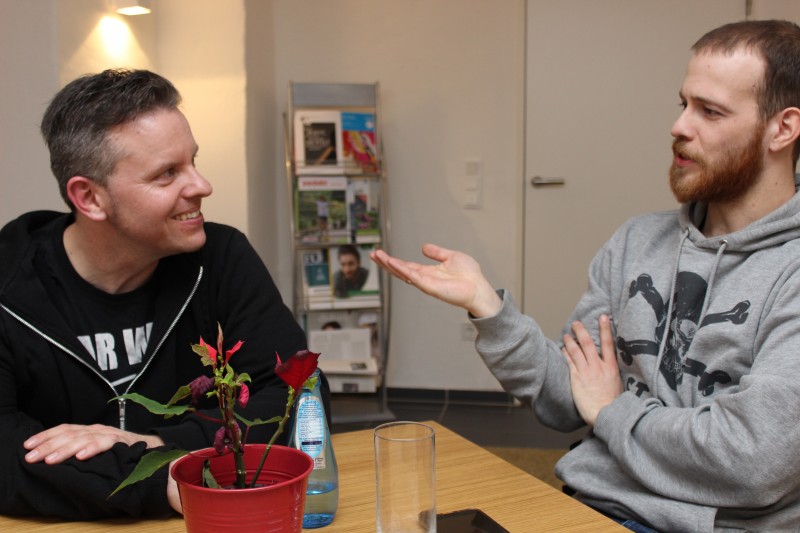
Photo: Stroke survivor Sascha Stachorra (left) helps actor Patrick Müller to prepare for his role.
Volunteer stroke-helpers
Volunteer stroke helpers support stroke survivors in their every day life. For example they get groceries together, accompany them for a walk or play board games. More and more people are interested in working as a volunteer in this field. This is why the foundation supports courses of instructions all over Germany. Local partners help organising the project, which is now offered in twelve regions.
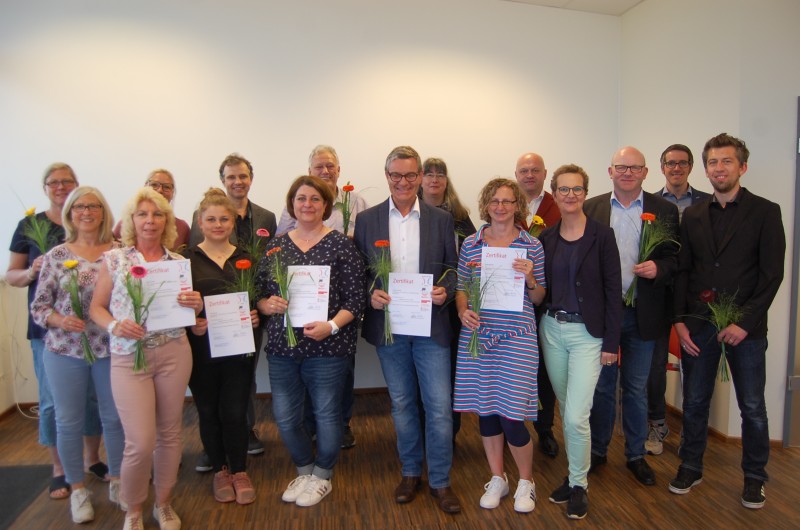
Day against stroke
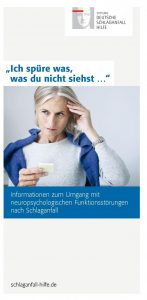 The national “Day against stroke” on May 10th is one of the most important days for communication about stroke related topics. The motto in 2019 “I feel something you can’t see…” is based on the German name of the child’s game “I spy with my little eye.”
The national “Day against stroke” on May 10th is one of the most important days for communication about stroke related topics. The motto in 2019 “I feel something you can’t see…” is based on the German name of the child’s game “I spy with my little eye.”
Main goal was to focus on the unseen consequences of stroke like difficulties to recall information or to concentrate, neglect, visual field fail and emotional changes. Many newspapers, TV- and radio stations reported about the topic and it was successfully spread across social media. #Taggegendenschlaganfall (#dayagainststroke) made it into the top 10 hashtags on twitter in Germany for the first time.
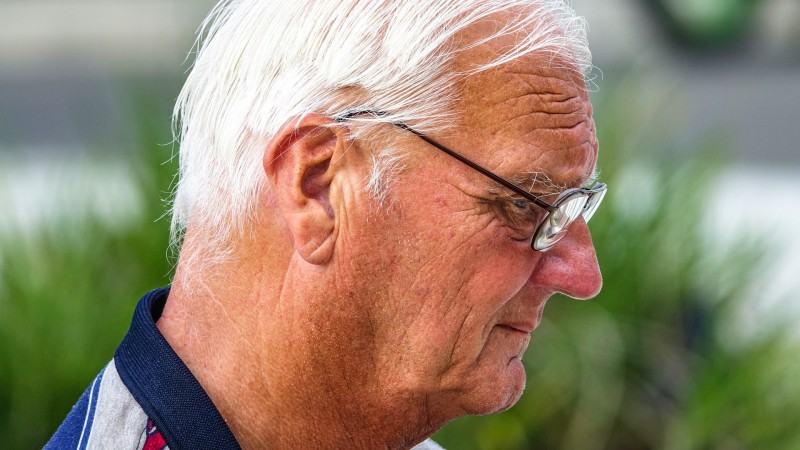
Jul 30, 2019
First published on ScienceDaily.com
Aging men with low testosterone levels who take testosterone replacement therapy (TRT) are at a slightly greater risk of experiencing an ischemic stroke, transient ischemic attack (TIA), or myocardial infarction, especially during the first two years of use, reports a study appearing in The American Journal of Medicine, published by Elsevier. The findings confirm concerns voiced by many health agencies about the potential risks associated with the treatment.
The study analyzed a large database of electronic medical records of patients enrolled in primary care practices in the United Kingdom and formed a cohort of 15,401 men, aged 45 years or older, with low testosterone levels (hypogonadism). Users of TRT had a 21 percent greater risk of cardiovascular events compared with nonusers, corresponding to an additional 128 events. The increased risk appears to be transient, declining after two years of TRT use, which the investigators attribute to a phenomenon called “depletion of susceptibles.”
“Our findings show that the use of TRT was associated with an increased risk of stroke, TIAs, or cardiac arrest during the first two years of use,” noted Christel Renoux, MD, PhD, Centre for Clinical Epidemiology, Lady Davis Institute for Medical Research, Jewish General Hospital; and Departments of Epidemiology, Biostatistics, and Occupational Health, and Department of Neurology and Neurosurgery, McGill University, Montreal, QC, Canada. “There is limited evidence on the long-term clinical benefits of TRT to effectively treat the modestly declining levels of endogenous testosterone levels of aging but healthy men. We strongly recommend that clinicians proceed with caution when considering prescribing TRT and first discuss both the potential benefits and risks with patients.”
Please read the full article here.
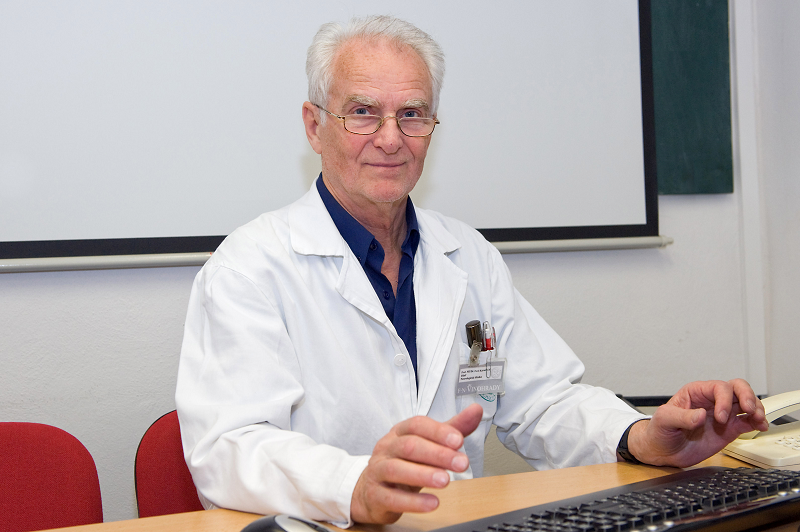
Jul 26, 2019
“The life of stroke victims is made difficult in several aspects. It is not only the physical handicap, but also a state of desolation. Family members can act against these troubles with good vigor and vitality, nevertheless a support of the surrounding society would be much helpful.” says Prof. Pavel Kalvach from Czech stroke support organisation Sdružení pro rehabilitaci osob po CMP (Czech Association for stroke victims).
SAFE: What is one issue related to the life after stroke in your country that you think needs special attention?
PK: This is a point, which we should stress in our Czech community: more clubs for stroke victims, for stroke carers, more encouragement in terms of mutual communications, music, creative activities. The people affected by stroke can produce these activities partly on their own, but they need necessarily organizational as well as logistic support. Given such meetings would be established, we could believe, that they could then run already spontaneously. Certainly much enthusiasm is needed to put these intentions into reality.
SAFE: What would be the solution, i.e. what is your organisation’s position regarding this issue?
PK: The Czech Association for rehabilitation of stroke victims provides counselling, provides courses, activates clubs throughout the country, but its reach is by far insufficient. Many healthy, retired people, who could actively contribute to the care of those less happy in their physical health state, ignore the needs of stroke individuals and thereby also their eventual personal pleasure of making good deeds. Our organization should be more proactive in sharing knowledge and encouraging people in those activities. Self-supporting groups could be conceived and we should reach out to put them in life.
SAFE: Please tell us more about your organisation.
PK: The activity that the Czech Association for stroke victims takes the most merit for is the arrangement of summer camps, aiming at rehabilitation. These courses occur in recreational regions of Czech republic. Care of physiotherapists, of medical doctors, psychologists and logotherapists is provided for groups of approximately 40 persons. These courses are financially supported by our Ministry of health, who would cover ½ of the expenses. The other ½ is covered by each person himself. Besides of the medical and psychological individual and group training also cultural activities are organized, like visits to the sightseeing around, or collective singing, or even dancing. People take great pleasure in such course, but the number of those, who achieve to participate is still too low: About 200 per year. If we compare this with the prevalence of stroke victims in Czech Republic, this number make less then 5% of people, who could profit.

Jul 24, 2019
First published on ScienceDaily.com
A new method of evaluating irregular heartbeats outperformed the approach that’s currently used widely in stroke units to detect instances of atrial fibrillation.
The technology, called electrocardiomatrix, goes further than standard cardiac telemetry by examining large amounts of telemetry data in a way that’s so detailed it’s impractical for individual clinicians to attempt.
Co-inventor Jimo Borjigin, Ph.D., recently published the latest results from her electrocardiomatrix technology in Stroke. Among stroke patients with usable data (260 of 265), electrocardiomatrix was highly accurate in identifying those with Afib.
“We validated the use of our technology in a clinical setting, finding the electrocardiomatrix was an accurate method to determine whether a stroke survivor had an Afib,” says Borjigin, an associate professor of neurology and molecular and integrative physiology at Michigan Medicine.
A crucial metric
After a stroke, neurologists are tasked with identifying which risk factors may have contributed in order to do everything possible to prevent another event.
That makes detecting irregular heartbeat an urgent concern for these patients, explains first author Devin Brown, M.D., professor of neurology and a stroke neurologist at Michigan Medicine.
“Atrial fibrillation is a very important and modifiable risk factor for stroke,” Brown says.
Importantly, the electrocardiomatrix identification method was highly accurate for the 212 patients who did not have a history of Afib, Borjigin says. She says this group is most clinically relevant, because of the importance of determining whether stroke patients have previously undetected Afib.
When a patient has Afib, their irregular heartbeat can lead to blood collecting in their heart, which can form a stroke-causing clot. Many different blood thinners are on the market today, making it easier for clinicians to get their patients on an anticoagulant they’ll take as directed.
Please read the full article here.



 The second “Case manager for children with stroke” (Schlaganfall-Kinderlotsin) was installed at the beginning of the year. Franziska Schroll works at the Schön Clinic in Vogtareuth (Bavaria) and will support families with stroke-affected children in southern Germany. The foundation “RTL – We help children” finances the project for two years.
The second “Case manager for children with stroke” (Schlaganfall-Kinderlotsin) was installed at the beginning of the year. Franziska Schroll works at the Schön Clinic in Vogtareuth (Bavaria) and will support families with stroke-affected children in southern Germany. The foundation “RTL – We help children” finances the project for two years.





 The national “Day against stroke” on May 10th is one of the most important days for communication about stroke related topics. The motto in 2019 “I feel something you can’t see…” is based on the German name of the child’s game “I spy with my little eye.”
The national “Day against stroke” on May 10th is one of the most important days for communication about stroke related topics. The motto in 2019 “I feel something you can’t see…” is based on the German name of the child’s game “I spy with my little eye.”





